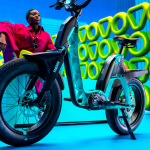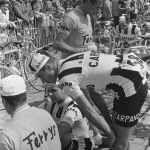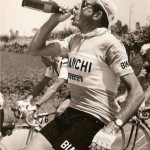
How has the aesthetics of track cycling changed?
Every detail matters to go faster
August 9th, 2024
If the Olympic shooters in Paris 2024 looked like characters from a cyberpunk universe, the entire aesthetic related to track cycling can be defined as futuristic or even sci-fi. Men and women with superhuman leg strength wear skin-tight suits that become transparent at the first drop of sweat, while on their heads, they sport ultra-aerodynamic helmets designed to cut through the air and race as fast as possible on ultralight bikes without brakes. Track cycling races have always been the technological laboratory of cycling, and the resulting aesthetic is a natural consequence. Appearance is of little concern; the goal is to go fast. Faster. It’s the only way to win a gold medal.
However, until the 1980 Moscow Olympics, the image of this sport was still relatively traditional. Track cyclists wore uniforms and helmets that somewhat resembled those used in road cycling, and the bikes appeared to be road bikes, particularly due to the presence of spoked wheels on both wheels. For example: Eddy Merckx set the hour record in 1972 on a Colnago bike that was cutting-edge for its materials at the time but aesthetically resembled a classic racing bike. The turning point came in 1984. First, in January of that year, Francesco Moser set a new hour record, this time on a bike that propelled track cycling into the future, a model with two disc wheels, with the rear wheel having a larger diameter than the front to ensure greater stability. The second turning point came at the Los Angeles Olympics: even today, the iconic image is that of Rory O’Reilly. The American track cyclist rode an unprecedented red superbike with a U-shaped handlebar, a rear disc wheel, and a very high, perforated seat tube to improve aerodynamic resistance. All this while wearing a skin-tight suit in the colors of the American flag and a pointed helmet.
Since those Olympics, track cycling has never looked back and began to take on the aesthetic we know today. Disc wheels have become dominant, and helmets have started to take on the strangest shapes based on wind tunnel experiments. Handlebars have evolved, O’Reilly’s U-shaped design was not abandoned but rather improved: it is now common to see track cyclists using two different handlebars, the classic low one and a central one with a narrower U-shape to rest their elbows on for better propulsion. Investments have become increasingly substantial in the pursuit of marginal gains: for example, a budget of over 30 million euros between 2009 and 2013 by the British federation led, among other things, to the creation of an innovative kit with shoulder seams designed to improve aerodynamics. The result? Seven gold medals out of ten events at the 2012 London Olympics.
The evolution has, of course, continued. In 2022, Italian Filippo Ganna set the new hour record on a Bolide F HR 3D, a hyper-technological model made by Pinarello with a total cost ranging between 60,000 and 75,000 euros. And at the Paris Olympics, we got an early taste of the direction track cycling is heading. The first final on the schedule was the women’s Sprint, and the gold medal went to Great Britain. Katy Marchant, Sophie Capewell, and Emma Finucane set the new world record riding the Hope HBT Paris, an evolution of the Lotus x Hope HB.T, the revolutionary carbon fiber bike used at the Tokyo Olympics, also made using 3D printing. An innovative model where the front part is designed so that the fork is wider and acts like a wing to reduce air resistance. Because every detail matters when you need to go fast. Faster.




















